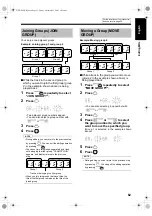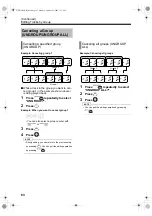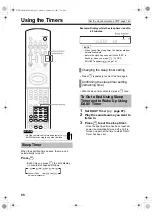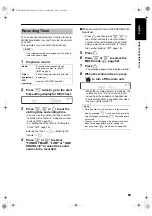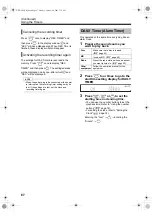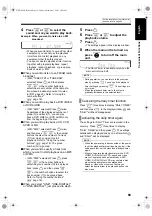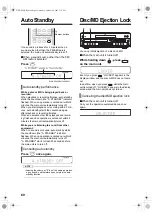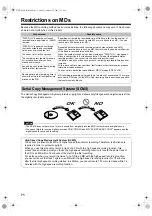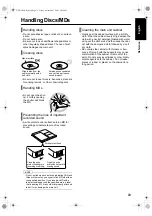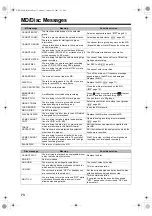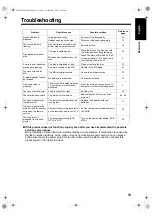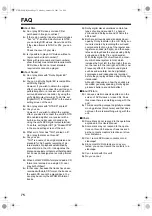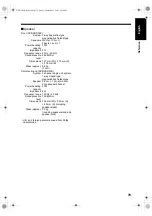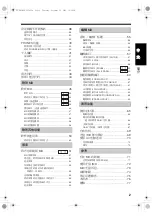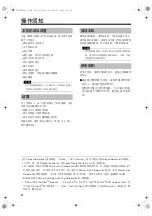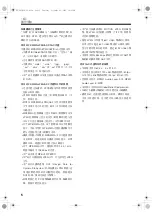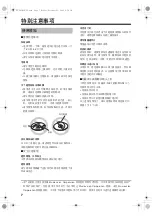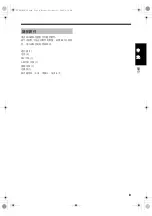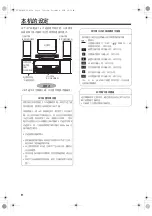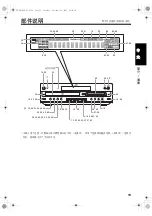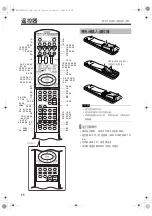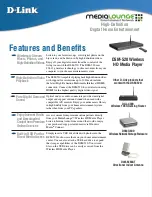
76
Re
fe
re
nce
En
glis
h
Glossary
B.S.P.
Static pictures from DVD audios may include not only
the pictures displayed automatically together with the
audio playback, but also the pictures that can be
optionally selected by users. These pictures are
called B.S.P (Browsable Still Picture).
Component
This is one of the video signals and refers to the
signal of the three primary colors of light (R/G/B) and
the other picture signal (color difference signal: Y /CB/
CR) that has been efficiently converted based on R/
G/B. Since each signal is transmitted via a separate
signal line, it makes it possible to transmit high quality
pictures.
Dolby Digital
This is one of the surround modes. It is capable of
dealing with up to 5.1 channel in total, which includes
front 3-channel, surround 2-channel, and sub-woofer
0.1-channel.
Dolby Surround
This is one of the surround modes. It records the total
4-channel sound signals of front surround into 2-
channel signals and then converts them back to 4-
channel signals via a special decoder when they are
played back. Since the sounds are recorded with 2-
channel, you can produce natural sounds even if you
connect it to stereo equipment.
Down Mix
This refers to the function that allows you to play back
the multi-channel sound tracks recorded with a
surround mode (3 or greater channels), mixing with
stereo 2-channel sounds.
D-Range Control
This function allows you to understand relatively low
sounds such as dialog clearly, even if you turn down
the volume of the TV in a loud volume scene, when
playing a DVD video recorded with Dolby Digital.
DTS (Digital Theater System)
This is one of the surround modes that offer a
maximum 5.1ch (same as Dolby Digital). Since this
format uses low sound compression rate, thicker
sounds with less noise can be produced.
Dynamic Range
This refers to the difference between the largest point
and the smallest point of the sound level.
Interlace Scanning (Jump Scanning)
This is a traditional video format, mainly used by TV.
JPEG (Joint Photographic coding Experts Group)
This is a static picture information compression
format this is used widely for Internet and digital
cameras.
Linear PCM Sound
This is one of the methods that convert analog sound
signals into digital sound signals. It does not require
compression at all at the time of conversion.
MLP (Meridian Lossless Packing)
This is a name of the multi-channel sound
compression format employed by DVD audios. The
compression ratio is about 1/2, and the compressed
data can be completely restored because a reversible
data compression method is available. It allows you to
play back high quality sounds.
MP3 (MPEG-1 Audio Layer-3)
This is the international standard for sound
information compression format that allows you to
compress data to one tenth its original size, without
greatly impairing the original sound quality.
MPEG Audio
This is a surround format that allows you to compress
sound data. It is capable of handling a maximum 7.1
channels.
NTSC
This is the TV/video format used in countries such as
Japan and the U.S. In European countries, other
formats (PAL or SECAM) are used. Since the number
of frames and the number of scanning lines are
different, the two formats are incompatible with each
other.
Packet write method
This is one of the methods used to record data onto
CD-R/RW that allows you to further divide tracks
before recording, depending on the free space
available on the disc. This unit is unable to play back
the sounds on CD-R/RW discs that have been
recorded using this method.
PBC (Playback Control)
This is the signal recorded with Video CDs (Version2)
to control the playback operation. You can use the
menu screen of recorded PBC enabled video CDs to
run interactive software and software with searching
capabilities. Furthermore, with video CDs on which
high definition still pictures are recorded, it allows you
to playback the still picture using resolution more than
four times larger than that for playing moving pictures.
Progressive scanning method (sequential
scanning)
This is the scanning method, used with DVD videos
and others, that enables you to display high quality
pictures without the flickering that normally
accompanies pictures produced using the interlacing
scanning method.
Region Number (Managing areas where tracks
can be played)
This refers to the system in which tracks on a disc can
be played only in the specified areas. You cannot play
tracks on a disc if the region number on the disc and
the region number on the DVD player do not
correspond.
Resume Playback
It refers to resuming playback from the point where
you have paused.
Screen Saver
Displaying a still picture on a TV screen for a long
time may sometimes cause screen burning, leaving a
burned-in image of the still picture. The screen saver
function prevents it from occurring.
VFP (Video Fine Processor) function
This is our original function that enables fine-tuning
(adjustment) of pictures. It allows you to adjust items
such as gamma correction to select brightness,
contrast, and intermediate brightness of the pictures,
depending on the preferences you make for your
software or room conditions. It even enables you to
display smooth pictures with deep tones, thus
producing a level of picture quality in movie films that
has been difficult to achieve so far.
WMA (Acronyms for Windows MediaR Audio)
This is the sound compression format developed by
Microsoft Corporation in the U.S.
NX-DD30[UB].book Page 76 Friday, November 25, 2005 10:26 AM

